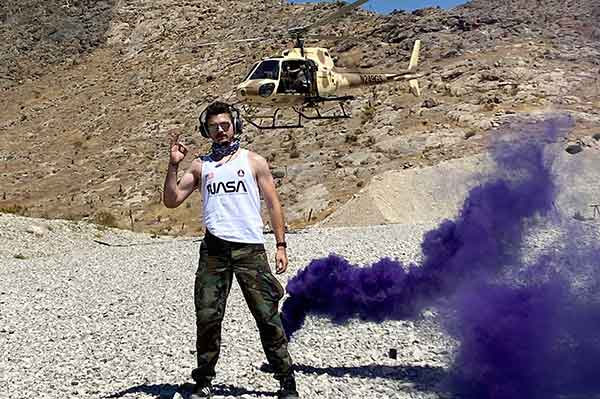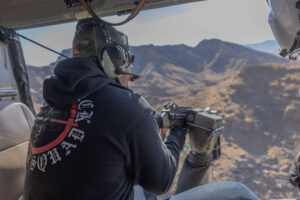The Evolution of Shooting Ranges: From Ground to Air is a comprehensive study of the transformation and advancement of shooting ranges over the years. It traces the journey from the early rudimentary ground ranges, used for basic target practice and military training, to the sophisticated modern-day facilities that incorporate advanced technology and simulate real-life scenarios. The narrative also explores the shift towards aerial shooting ranges, which are designed to train individuals in the skills required for airborne operations. This evolution reflects the changing needs of military, law enforcement, and civilian shooters, as well as advancements in technology and weaponry.
Tracing the Shooting Range History: A Journey from Ground to Sky
The evolution of shooting ranges, from their humble beginnings on the ground to their modern-day incarnations in the sky, is a fascinating journey that reflects the advancements in technology and the changing needs of society. This journey, which spans centuries, is marked by innovation, adaptation, and a constant striving for excellence.
The earliest shooting ranges can be traced back to the Middle Ages, when archery was a vital skill for survival and warfare. These ranges were simple, open fields where archers could practice their aim and hone their skills. The targets were usually stationary, and the focus was on accuracy rather than speed or agility. As firearms became more prevalent, these ranges evolved to accommodate the new technology. Targets became more complex, and the ranges themselves became more structured, with designated shooting lanes and safety protocols.
The 19th century saw the advent of the modern shooting range. These ranges were designed to mimic real-world combat situations, with moving targets and varying distances. They were often located in urban areas, making them accessible to a wider audience. The popularity of these ranges grew rapidly, and they became a common feature in many cities.
The 20th century brought about significant changes in the design and function of shooting ranges. The advent of automatic weapons necessitated the development of ranges that could accommodate rapid-fire shooting. These ranges featured advanced target systems, including pop-up targets and moving targets that could simulate the unpredictability of a real combat situation. Safety became a paramount concern, with the introduction of bullet traps and soundproofing to protect shooters and bystanders.
The most significant evolution in shooting ranges, however, has occurred in the 21st century with the advent of virtual reality (VR) technology. Today’s shooting ranges are no longer confined to physical spaces; they can now exist in the virtual realm. VR shooting ranges allow for an unprecedented level of realism and immersion. Shooters can engage in scenarios that would be impossible to replicate in a traditional range, from zombie apocalypses to intergalactic battles. These ranges also offer the advantage of being completely safe, as the bullets are virtual and there is no risk of injury or damage.
The evolution of shooting ranges from ground to air is a testament to human ingenuity and the relentless pursuit of improvement. Each new development, from the simple archery ranges of the Middle Ages to the high-tech VR ranges of today, has been driven by the desire to provide a better, more effective training environment for shooters. As technology continues to advance, it is exciting to imagine what the future holds for shooting ranges. Perhaps we will see ranges that incorporate augmented reality, or ranges that can simulate the conditions of other planets. Whatever the future holds, one thing is certain: shooting ranges will continue to evolve, pushing the boundaries of what is possible and providing ever more engaging and effective training experiences.
The Evolution of Gun Ranges: An In-depth Look at Aerial Shooting Ranges
The evolution of shooting ranges has been a fascinating journey, marked by technological advancements and innovative practices. From the rudimentary shooting grounds of the past to the sophisticated aerial shooting ranges of today, the transformation has been nothing short of remarkable. This article delves into the evolution of gun ranges, with a particular focus on the advent and development of aerial shooting ranges.
In the early days, shooting ranges were simple, ground-based facilities. They were primarily used for military training, law enforcement, and hunting practice. These ranges were typically open fields with targets placed at varying distances. The shooter would stand at a fixed point and aim at the targets, honing their accuracy and precision. Over time, these ranges evolved to include more complex target systems, safety measures, and shooting scenarios.
The advent of the 20th century brought about significant changes in the design and purpose of shooting ranges. The rise of recreational shooting and competitive marksmanship led to the development of indoor ranges. These facilities offered a controlled environment for shooters, with advanced target systems and improved safety measures. They also provided a platform for shooters to practice and compete regardless of weather conditions.
However, the most significant evolution in shooting ranges came with the advent of aerial shooting ranges. These ranges were initially developed for military purposes, to train pilots in air-to-air combat. Aerial shooting ranges provided a realistic environment for pilots to practice shooting at moving targets in the air. This was a significant departure from traditional ground-based ranges, as it introduced the element of three-dimensional movement.
Aerial shooting ranges are typically large, open-air spaces, often located over bodies of water or uninhabited land for safety reasons. They use a variety of target systems, including drones, balloons, and towed targets. The shooter, usually in an aircraft, must track and hit these moving targets, which requires a high degree of skill and precision.
The development of aerial shooting ranges has been driven by advancements in technology. Modern ranges use sophisticated tracking systems to monitor the flight path of targets and the accuracy of shots. They also employ advanced safety measures to prevent accidents and minimize environmental impact. For instance, many ranges now use biodegradable targets and non-toxic ammunition to reduce pollution.
In recent years, the use of aerial shooting ranges has expanded beyond military training. They are now used for recreational shooting and competitive sports, such as clay pigeon shooting. Some ranges even offer virtual reality simulations, allowing shooters to practice in a variety of scenarios without the need for physical targets or ammunition.
The evolution of shooting ranges, from ground to air, reflects the ongoing quest for realism, precision, and safety in shooting practice. As technology continues to advance, we can expect further innovations in the design and operation of shooting ranges. Whether for military training, law enforcement, competitive sports, or recreational shooting, these facilities will continue to play a crucial role in the development of shooting skills.
In conclusion, the journey from rudimentary shooting grounds to sophisticated aerial ranges is a testament to human ingenuity and the relentless pursuit of excellence. As we look to the future, the evolution of shooting ranges promises exciting developments in the realm of shooting practice and training.
From Ground to Air: The Remarkable Transformation of Shooting Ranges
The evolution of shooting ranges, from their humble beginnings on the ground to their current state in the air, is a fascinating journey that reflects the advancements in technology and the changing needs of the shooting community. This remarkable transformation has not only revolutionized the way we practice shooting but also enhanced the safety and efficiency of this activity.
In the early days, shooting ranges were simple, ground-based facilities. They were typically open fields with targets placed at varying distances. Shooters would stand at a fixed point and aim their firearms at these targets, honing their accuracy and precision. These ranges were often rudimentary, lacking the sophisticated safety measures and equipment we see today. However, they served their purpose, providing a controlled environment where individuals could practice their shooting skills.
As firearms technology advanced, so did the need for more complex shooting ranges. The introduction of automatic weapons necessitated the development of ranges that could accommodate rapid-fire shooting. This led to the creation of shooting galleries, enclosed spaces with mechanized targets that moved along tracks. These galleries provided a more dynamic shooting experience, allowing individuals to practice tracking and hitting moving targets.
The mid-20th century saw another significant shift in shooting range design with the advent of indoor ranges. These facilities offered a controlled environment, unaffected by weather conditions, where shooters could practice year-round. Indoor ranges also introduced new safety features, such as bullet traps and sound dampening materials, to minimize the risk of accidents and protect the hearing of shooters.
In recent years, the evolution of shooting ranges has taken an even more dramatic turn with the development of virtual reality (VR) technology. VR shooting ranges have brought the practice of shooting into the digital age, offering an immersive experience that traditional ranges cannot match. These ranges use VR headsets and simulated firearms to create a variety of shooting scenarios, from target practice to tactical training exercises. The use of VR technology also allows for instant feedback, helping shooters to improve their skills more quickly.
The latest innovation in shooting range technology is the introduction of aerial shooting ranges. These ranges, often housed in large, open-air structures, use drones to present moving targets in three-dimensional space. This adds a new level of challenge and complexity to the shooting experience, requiring shooters to track and hit targets that can move in any direction. Aerial shooting ranges also offer the potential for more realistic training scenarios, particularly for military and law enforcement personnel.
The evolution of shooting ranges, from ground to air, is a testament to the ingenuity and adaptability of the shooting community. As technology continues to advance, we can expect to see further innovations that will continue to transform the way we practice shooting. Whether you’re a casual shooter or a professional marksman, these advancements offer exciting new opportunities to hone your skills and enjoy the sport of shooting.
In conclusion, the journey of shooting ranges from simple ground-based facilities to sophisticated aerial ranges is a fascinating reflection of technological progress. It is a journey that has not only revolutionized the practice of shooting but also enhanced its safety and efficiency. As we look to the future, we can anticipate even more exciting developments in this field.
Q&A
1. Question: How have shooting ranges evolved from ground to air?
Answer: Shooting ranges have evolved significantly over time. Initially, they were simple outdoor areas used for target practice with firearms. With advancements in technology, shooting ranges have expanded to include simulations of air targets, using advanced systems that can mimic the flight patterns of various aircrafts. This allows for more comprehensive training for military and law enforcement personnel.
2. Question: What technological advancements have contributed to the evolution of shooting ranges?
Answer: Technological advancements such as computer simulations, automated target systems, and virtual reality have greatly contributed to the evolution of shooting ranges. These technologies allow for a more realistic and diverse training experience, including the simulation of various weather conditions, terrains, and target movements.
3. Question: What is the significance of the evolution of shooting ranges from ground to air?
Answer: The evolution of shooting ranges from ground to air is significant as it allows for more comprehensive and realistic training. This is particularly important for military and law enforcement personnel who may need to engage targets in the air. It also allows for safer training conditions, as the use of virtual reality and simulations can reduce the risk of accidents.The evolution of shooting ranges from ground to air signifies the advancement in technology and the changing needs of military training and recreational shooting. Initially, shooting ranges were primarily ground-based, focusing on improving accuracy and precision in shooting stationary or moving targets. However, with the advent of aircrafts and the increasing need for aerial defense, shooting ranges evolved to include air targets. This transition not only enhanced the complexity and diversity of shooting training but also increased the realism and applicability of these exercises. Therefore, the evolution of shooting ranges from ground to air reflects the continuous innovation and adaptation in response to changing military strategies and technological advancements.






